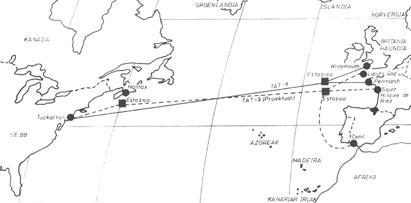Optical cable across the Atlantic
The line has a length of 6,680 km. Cable implantation began at Tuckerton in New Yersey. The American company ATT (American Telephone and Telegraph) has installed most of the wiring, 5,855 km. The cost of this work has been 250 million dollars. The British association Standard Telephones and Cables will establish the last 520 km from the connecting station that will be submerged to the town of Widemouth, for which it will spend 52 million dollars. The branch from the connecting station to the Penmarch of Brittany will be established by the French company CIT Alcatel with 310 km of cable and 33 million dollars. ATT will be responsible for making the three 25-year systems compatible.

The TAT-8 cable consists of two pairs of fiber optic cables crossed by a 1.3 micron laser beam. Since the data transmission rate used is 296 Mbps, the total transmission of the ten numbers of the Larousse encyclopedic dictionary could take about twelve seconds. On the other hand, repeaters will be installed along the entire line, that is, devices that receive the signal from the cable and generate the same but without noise and with greater power. The distance between repeaters is 57.5 km. At the end of the line, photon detectors will convert the light impulses into electrical impulses so that they later form videos or analog sound signals.
The first transatlantic cable was the telegraph line established between Newfoundland and Ireland in 1858. But until 1956 the transmission of telephone calls was made by radio. It was then that the first transatlantic cable used for telephony, the TAT-1, was established. He joined the United States with Scotland and his capacity was 52 telephone conversations at a time. Since then the number of marine cables has been growing uninterruptedly.
The idea of optical transmissions is ancient, but only after the invention of the laser. One of the main problems that had to be solved in the development of this communications system was that of the transmission support, since the air was not adequate due to the signal losses it generated. In 1970 it was shown that fiberglass was the best support.
Optical fibers have several advantages: the transmission systems used by copper cables require a kilometer and a half repeater to reinforce the signal, while optical fibers require a repeater of 50 kilometers each, as discussed above. On the other hand, optical fiber does not drive electricity, so it does not suffer electrostatic interference that decrease the quality of the transmissions. These interferences make the noise level (i.e. no signal voltage) relatively high in current copper cables.
Currently there is a half-second delay in satellite links of transatlantic transmissions, which account for 60% of the total, generating an uncomfortable echo in voice communications. These delays are logically due to the structure of the system itself. The signal must travel to a satellite away from Earth at 36,000 km and return again with half a second. Optical fibres do not present such failures and are much more difficult to spy on than copper cables and satellites, which is a feature of great importance for banks and governments.
However, American satellite companies do not yield easily and recognize that satellites are for a long time. The hardest argument of satellite supporters in this debate is the fragility of the fiber optic cable. It may happen that the optical cable breaks and takes about 6 months to locate the break and repair it. Two years ago ATT's discovered that optical cables emit a signal that attracts sharks, and on more than one occasion they have yellowed and broken the cable. Then ATT engineers cover the bald with another harder layer.
There is another problem. Its fragility forces to leave the optical cable at the bottom of the sea with precision and slowness. In the implementation of the TAT-8, the first 1830 kilometers of the American area have been quite difficult, since the continental platform is not very stable. The cable has therefore been buried 60 cm by the robot. For the path that remained, the robot has dug a ditch to accommodate the cable and then has been covered with whirlpools of marine water. The cable was abandoned at an average speed of 10 km/h.
In 1991 a new transatlantic cable called TAT-9 will be installed. It will cost 400 million dollars and will have twice the transmission capacity of the TAT-8. But earlier this year, 16,000 km of fiber optic cables will also be installed in the Pacific to communicate between California, Hawaii, Guam, the Philippines and Japan. The entire project will cost about 600 million dollars.
As you can see, the success of optical cables is spectacular and is becoming increasingly important among the current transmission brackets.






